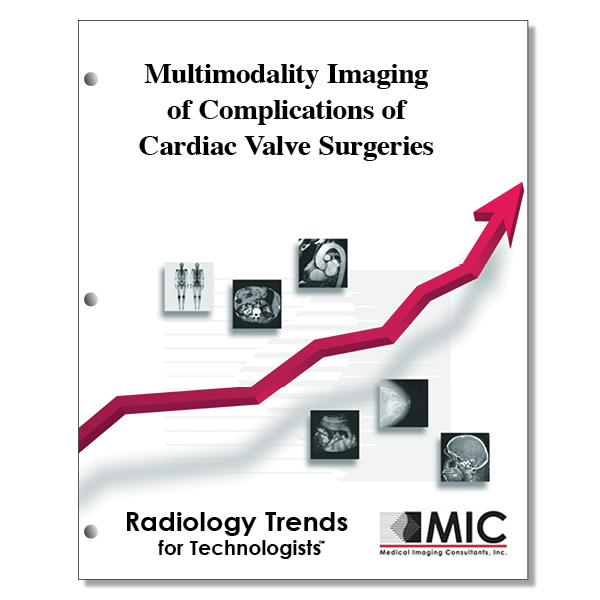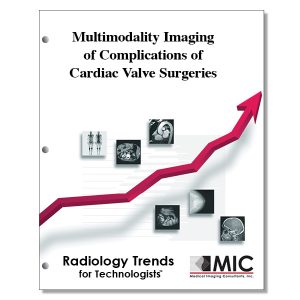

Multimodality Imaging of Complications of Cardiac Valve Surgeries
The role imaging modalities play in the evaluation of prosthetic heart valve dysfunction is examined.
Course ID: Q00593 Category: Radiology Trends for Technologists Modalities: Cardiac Interventional, CT, MRI, Nuclear Medicine, Sonography3.5 |
Satisfaction Guarantee |
$37.00
- Targeted CE
- Outline
- Objectives
Targeted CE per ARRT’s Discipline, Category, and Subcategory classification for enrollments starting after January 27, 2023:
[Note: Discipline-specific Targeted CE credits may be less than the total Category A credits approved for this course.]
Cardiac-Interventional Radiography: 2.75
Procedures: 2.75
Diagnostic and Electrophysiology Procedures: 2.75
Computed Tomography: 2.75
Procedures: 2.75
Neck and Chest: 2.75
Nuclear Medicine Technology: 0.75
Procedures: 0.75
Other Imaging Procedures: 0.75
Radiography: 0.75
Procedures: 0.75
Thorax and Abdomen Procedures: 0.75
Registered Radiologist Assistant: 2.75
Procedures: 2.75
Thoracic Section: 2.75
Outline
- Introduction
- Imaging Modalities for Evaluating PHVs
- Imaging Evaluation of PHVs
- Complications of PHVs
- Hemodynamic and Pathophysiologic Consequences
- Stenosis
- Regurgitataion
- Stuck Leaflet
- Structural Abnormalities
- Prosthesis-Patient Mismatch
- Structural Failure
- Valve Calcification
- Dehiscence
- Paravalvular Leak
- Infective Endocarditis and Vegetation
- Abscess
- Pseudoaneurysm
- Abnormal Connections
- Thrombus
- Hypoattenuating Leaflet Thickening
- Pannus
- Aortic Dissection
- Hemodynamic and Pathophysiologic Consequences
- Miscellaneous Complications
- Imaging Approach to Prosthetic Valves and Dysfunction
- Conclusion
Objectives
Upon completion of this course, students will:
- state the number of PHV replacements over the past 5 decades
- list the characteristics of an ideal PHV
- recall the types of currently available PHVs
- list the designs of mechanical heart valves
- recall what stentless bioprostheses are made from
- state the locations for placement of PHVs
- list the imaging modalities that play a role in the evaluation of PHVs
- name the most common first-line imaging test performed for PHV dysfunction
- list the supplemental ultrasound modes used for evaluation of PHVs
- describe how magnetic resonance imaging is helpful in the evaluation of PHVs
- state the emerging technique that provides flow measurements comparable to echocardiography.
- list the assessment methods that should be included in the evaluation of PHVs.
- recall how mechanical valves distort at magnetic resonance imaging.
- list the common hemodynamic and pathophysiologic consequences associated with PHVs
- define regurgitation
- describe how PHV regurgitation is quantified at echocardiography
- differentiate between TTE and TEE for the evaluation of PHVs
- recall the normal opening angle for monoleaflet valves as seen at computed tomography
- describe the imaging modalities that allow real-time imaging across many heartbeats
- describe the results of prosthesis-patient mismatch
- recall the percentage of moderate prosthesis-patient mismatch seen in aortic valve replacements
- list the factors that can help minimize prosthesis-patient mismatch
- state the common causes of structural failure of bioprosthetic heart valves
- recall the ideal imaging modality for demonstrating structural failures of PHVs
- describe the most common cause of sterile valvular degeneration in a bioprosthetic valve
- explain how valve calcification may appear at echocardiography
- describe the most common cause of early reoperation for valvular malfunction
- describe where dehiscence mainly occurs in the mitral valve
- list the clinical features of dehiscence
- list the causes of paravalvular leak
- explain the percent of surgeries that result with large paravalvular leaks
- describe where paravalvular leaks are seen in the mitral valve
- list the complications associated with infective endocarditis
- list the factors that place patients at a higher risk for pseudoaneurysm
- describe the imaging modality that has 100 percent accuracy in the diagnosis of pseudoaneurysm
- list the therapeutic options for pseudoaneurysm
- state the most common type of aortocavitary fistula
- describe the common location of a Gerbode defect
- state the percent of thrombus related to PHVs
- list the factors associated with a lower risk of thrombosis
- state the most common cause of obstruction of a mechanical PHV
- list the possible manifestations associated with obstructive thrombi
- note the prevalence of pannus
- describe how pannus appears at echocardiography
- state the prevalence of aortic dissection
